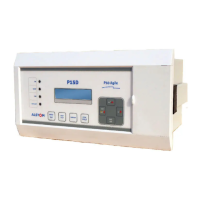2.2.1 Thermal Overload protection implementation
The device incorporates a current-based thermal characteristic, using fundamental load current to
model heating and cooling of the protected plant. The element can be set with both alarm and trip
stages.
Thermal Overload protection is implemented in the THERMAL OVERLOAD column of the relevant
settings group. The magnitudes of the three phase input currents are compared and the largest
magnitude is taken as the input to the thermal overload function.
Thermal over load function supports setting for alarm and trip stages. If the thermal overload function
is enabled and thermal state of the protected equipment exceeds the alarm threshold setting, the
alarm is issued and indicated by illuminated START LED on the relay front panel.
If the thermal overload function is enabled and thermal state of the protected equipment exceeds the
Trip threshold setting, a trip command is issued resulting in operation of output contacts and
generation of low energy pulse output. Trip condition is indicated by illuminated TRIP LED.
The thermal state measurement is made available in the MEASUREMENTS menu.
The thermal state can be reset from the HMI panel by pressing front panel Touch key RESET / EDIT +
PROT. RESET
2.3 Undercurrent protection function
The relay includes undercurrent elements that can be used to provide additional functions to prevent
damage to the power system. This function allows typical applications such as loss of load. The
undercurrent protection function is available only if the auxiliary contact of the CB status is connected
to the relay, for example, when NO contact of CB is high.
Note: For proper operation of this function the relay should have auxiliary power supply.
2.4 Cold Load Pickup function
When a feeder circuit breaker is closed in order to energise a load, the current levels that flow for a
period of time following energisation may be far greater than the normal load levels. Consequently,
overcurrent settings that have been applied to provide overcurrent protection may not be suitable
during this period of energisation (cold load), as they may initiate undesired tripping of the circuit
breaker. This scenario can be prevented with Cold Load Pickup (CLP) functionality.
The Cold Load Pickup (CLP) logic works by either:
• Inhibiting one or more stages of the overcurrent protection for a set duration
• Raising the overcurrent settings of selected stages, for the cold loading period.
The CLP logic therefore provides stability, whilst maintaining protection during the start-up.
Cold Load Pickup Protection is implemented in the COLD LOAD PICKUP column of the relevant
settings group.
This function acts on the following protection functions:
• All overcurrent stages
• All Earth Fault stages
The principle of operation is identical for the 3-phase overcurrent protection and Earth Fault
overcurrent protection.

